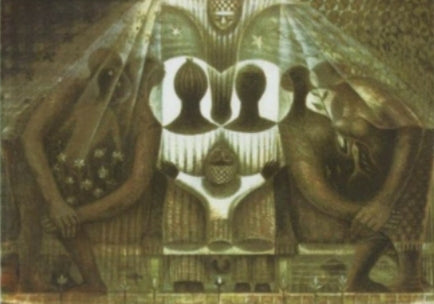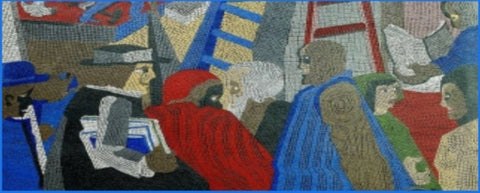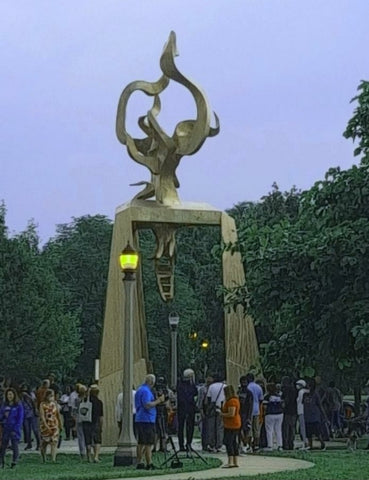How Public Art Projects Expanded Opportunities for a Generation of Black Artists, Part 2
By Yvonne Bynoe
Part 1 of this series explored early public art by African-American artists starting in the 1930s with commissions that they received from the WPA's Federal Arts Program and from historically Black colleges and universities. During a period when African-American artists were barred from exhibiting in major museums and galleries, public art projects were vital for getting exposure for their work and developing their professional reputations.
In Part 2, we'll delve further into some of the most influential Black artists of the 20th century and the public works that they created later in their careers. It's important to note that, although today, works by these artists easily garner six and seven figures at auctions, during their lifetimes they often sold their works for modest fees. Consequently, public art commissions were important supplemental income.
We'll also look at contemporary artist, Kerry James Marshall, and the thorny issue of public art being sold to private collectors. The paradox that Marshall illustrates is that when a Black artist gains significant recognition is exactly the time when his or her work is most in danger of being removed from public spaces, particularly in Black communities, and transferred into private hands.
Romare Bearden (1911-1988)
Romare Bearden, a prolific artist, is recognized as one of the most important visual artists of the 20th century. Bearden worked in various mediums, but he is best known for his richly detailed collages that portray Black American life both in the South and in the North. He had firsthand knowledge above and below the Mason-Dixon line. Bearden was born in Charlotte, North Carolina, raised in Harlem, and, as a youth, spent time in Pittsburgh, Pennsylvania. Bearden was multifaceted and his life experiences were reflected in his art.
Professionally, Bearden held various jobs, including cartoonist and a successful advertising jingle writer. From the mid-1930s through the 1960s, Bearden was a social worker with the New York City Department of Social Services. He worked on his art at night and on weekends. Bearden was also active in the New York arts community. He helped to found the Studio Museum in Harlem and, in 1963, co-founded the SPIRAL group to support the Civil Rights movement, and the Cinqué Gallery, a venue for emerging artists of color, with fellow artists, Norman Lewis and Ernest Crichlow.
Bearden's work is included in many important public collections including the Metropolitan Museum of Art; the Whitney Museum of American Art; the Philadelphia Museum of Art; the Museum of Fine Arts, Boston; and The Studio Museum in Harlem, among others.
Bearden received commissions to create numerous public art projects throughout the United States. Among them includes:


Photo credit: Bearden Foundation

"Baltimore Uproar" (1983), Baltimore, Maryland
Upton/Market Avenue Metro Station
Photo credit: Bearden Foundation

"Pittsburgh Recollections" (1984),
Gateway Center T Station, Pittsburgh Allegheny Rapid Transit Authority
Ceramic tile mural composed of 780 tiles. It was made by Bennington Potters, Inc.
Photo credit: Bearden Foundation

"The Tree of Life: Symbol of Salvation"
(undated), Harlem, New York
St. Martin’s Church (formerly St. Philip's Church)
Photo credit: St. Martin's Church, photographer unknown[/caption]
Bearden's father and mother belonged to the congregation, and he was an occasional member.
John T. Biggers (1924-2001)
John T. Biggers is best known for his murals, while also being well-respected for his drawings, prints, and sculptures. The artist was influenced by his Southern roots and later, African art. In the 1940s, Biggers style was social realism portraying what he saw and experienced as a young African-American man. In the 1950s, after a trip to the continent of Africa, his works were infused with depictions from traditional African cultures.
A native of Gastonia, North Carolina, Biggers established and chaired the Department of Art at Texas Southern University in Houston for 34 years, before retiring in 1983. In 1988, he was recognized as the Texas Artist of the Year. (Selected works)

"The Contribution of Negro Women in American Life and Education" (1953),
Located on a wall inside the Blue Triangle Multi-Cultural Association’s building, Houston, Texas
Photo credit: Blue Triangle Community Center

Texas Southern University Student Life Center, Hanna Hall Photo Credit: Texas Southern University

"Origins" (installed 1992), and "Ascension" (installed 1992),
Two murals commissioned by Delta Fine Arts for Winston-Salem State University, O'Kelly Library
Texas Southern University
After learning that, during his 47-year career, Bigger had not painted one in his home state of North Carolina, Winston-Salem Delta Fine Arts decided to undertake a mural project. Biggers began the project in 1990, and Delta Fine Arts presented the murals to the university on March 28, 1992. Twenty years prior, in 1972, Winston-Salem Delta Fine Arts was created as an initiative of the Winston-Salem alumnae chapter of Delta Sigma Theta Sorority, Inc. to highlight the work of African-American artists.
Selected murals by John T. Biggers in Texas:
History of Negro Education, Morris County, Texas (1954) Commission in honor of Professor Phineas Y. Gray (1886-1976) of George Washington Carver Negro High School
Web of Life (1962), University Museum, Texas Southern University
Nubia, Origins of Business and Commerce (1999, with Harvey Johnson), Texas Southern University Jones Business School.
Birth from the Sea (1966), W.L.D. Johnson Branch, Houston Public Library.
The Quilting Party (1981), Music Hall, now at the Wortham Center.
Christia Adair (1983), Christia V. Adair Park, Harris County.
Song of the Drinking Gourd (1987), Tom Bass Regional Park III, Harris County.
Salt Marsh (1998, with Harvey Johnson), University of Houston-Downtown.
(See also Hampton University, Part I)
Elizabeth Catlett (1915-2012)
Elizabeth Catlett is regarded as one of the preeminent artists of the 20th century. Catlett's work explored issues of race, class and female identity, influencing generations of artists in her home country of the United States and in Mexico, where she lived from 1946 to the end of her life.
Catlett was the granddaughter of former enslaved Black Americans. She was raised in Washington, D.C. and graduated from Howard University in 1935, where her teachers included artist, Loïs Mailou Jones, and philosopher, Dr. Alain Locke, often called the "Father of the Harlem Renaissance."
Her most iconic work is arguably The Sharecropper (1952), a rendering of an anonymous Black woman sharecropper. The compelling linocut brought attention to the horrific plight of tenant farmers (sharecroppers) in the South who paid for the land they rented with part of their crop, often resulting in lifelong debt. Since Black sharecroppers didn't have the power to dispute charges or even review their accounts with White landowners, many considered sharecropping to be indentured servitude.

Unframed and Unsigned. ($350.00)

Ralph Ellison Memorial (2002-2003), Riverside Park, New York, NY
Bronze bronze deer isle granite | 15 x 7' 6" x 6"
Photo credit: City of New York
The Ralph Ellison Memorial—honoring Ralph Ellison and his 1952 novel, Invisible Man—was Catlett's first commissioned public work in New York City. Invisible Man was also the inspiration for Kerry James Marshall's Portrait of the Artist as a Shadow of His Former Self (1980).
(See also Howard University, Part 1)
Jacob Lawrence (1917-2000)
Harlem native, Jacob Lawrence, is an American master who is considered by many art scholars to be the premiere African-American artist of the 20th century. His body of work focuses on the Black American experience in the United States. Lawrence's capstone work is The Migration Series (1940–41), which was created when he was 23 years old. The 60-panel series depicts the post–World War I migration of African-Americans from the rural South to the industrial cities in the North. He stated that he made the Migration Series to tell an important story in American history that had been omitted.
Lawrence began painting some of his earliest works at the Harlem Community Art Center, directed by sculptor, Augusta Savage. Lawrence's other important work includes his series of panels on the lives of important African Americans in history including:
The Life of Toussaint L’Ouverture, 1937, (forty one panels)
The Life of Frederick Douglass, 1938, (forty panels)
The Life of Harriet Tubman, 1939, (thirty one panels)

Washington (1991), Chicago, Illinois
Harold Washington Library
Photo credit: City of Chicago Public Art Collection
This monumental work recognizes the late Harold Washington (1922-1987), who was elected the first African-American mayor of Chicago in 1983. The mural depicts Washington's accomplishments as a student, Civilian Conservation Corps worker, U. S. soldier, lawyer, congressman, and mayor of Chicago.

UNTITLED (2001), New York, New York
Times Square-42nd Street subway station.
Glass mosaic on stairway wall.
Photo credit:
MTA Arts and Design
In 1997, Lawrence completed the design for a 72-foot long mural that was installed in 2001 in the new Times Square Subway Complex at Broadway and 42nd Street in New York City.
Not pictured:
Theater (1985), University of Washington in Seattle, main lobby of the Meany Hall for the Performing Arts
(See also Joseph P. Addabbo Federal and Howard University, Part 1)
Joseph P. Addabbo Federal Building, Jamaica, New York (borough of Queens) Regional Social Security Office
(Selected works)
While the intention to bring the work of African-American artists to the new federal building located in South Jamaica, a predominantly Black community was universally praised, some questioned the works by artists who had no association with the borough. While Lawrence and Bearden were revered, like seven of the eight artists who were chosen, neither had ever lived in Queens. Critics were also concerned that the works of the older artists didn't truly express the spirit of the neighborhood and that, stylistically, they were misaligned with the modern building.

Jacob Lawrence, Community (1989)
10' x 12'
In Community, Lawrence portrays the vibrancy and energy of the bustling streets around the federal building in a work that's a statement about labor and collective effort.
 Romare Bearden, "Family" (1989),
Romare Bearden, "Family" (1989),
Family is Bearden's last work, and it was replicated from a collage inspired by his childhood in Charlotte North Carolina, which depicts several generations of a family in their home.
Richard Hunt (b.1935)
Richard Hunt has been called one of the most important African-American sculptors in the United States of the 20th century. In 1957, while he was a student at the School of the Art Institute of Chicago (SAIC), the Museum of Modern Art (MOMA) purchased one of his works. Thereafter, his sculptures were exhibited at major museums such as the Whitney Museum of American Art, the Cleveland Museum of Art, and the Art Institute of Chicago. In 1969, Ebony magazine hailed him as “one of the foremost sculptors in the country.” Two years later, in 1971, MOMA mounted Hunt's first retrospective, "The Sculpture of Richard Hunt."
Today, Hunt's more than 150 public sculptures can be found across the country in spaces that range from bucolic parks to impressive skyscrapers. He has been commissioned by corporations, hospitals, museums, municipalities, universities, and athletic organizations.
Hunt's public sculptures marry abstract art with the experiences of African Americans, as evidenced in such works as Freedmen’s Column, (1989) one of three of his works at Howard University in Washington. Howard University was founded in 1867 in the aftermath of the Civil War under the federal Freedmen's Bureau. I Have Been to the Mountaintop (1977) is a memorial to Dr. Martin Luther King, Jr., in Memphis, Tennessee, where he was assassinated. His welded bronze sculpture, Swing Low (2016), hangs in the lobby of the National Museum of African American History and Culture in Washington, D.C., the newest addition to Smithsonian Institution.

Photo credit: UNKNOWN
The 30-feet tall monument to journalist-activist, Ida B. Wells was installed in Bronzeville on the site of the Chicago Housing Authority’s Ida B. Wells Homes, which were demolished in 2011. It is the first monument in Chicago to honor an African-American woman.
(See also: Howard University, Part 1 of series)
Kerry James Marshall (b. 1955)
Kerry James Marshall was born in Birmingham, Alabama in the era of Jim Crow, raised in the Watts community of Los Angeles during the Civil Right era and lives in Bronzeville, a historically African-American community in Chicago. He's a bridge between the groundbreaking Black artists of the early 20th century whose careers and livelihoods were constricted by racial segregation and a younger generation of high-profile Black artists who are widedly celebrated in the art world and whose works command large fees.
Marshall's career started in 1980 when the 25-year-old recent art school graduate painted his seminal Portrait of the Artist as a Shadow of His Former Self inspired by Ralph Ellison's 1952 novel, Invisible Man. The work is foundational to his oeuvre of large scale narrative works that feature black figures. The dark figures serve as a blatant articulation of blackness in an art world where Black people historically have even rendered invisible.
In 1985, Marshall became an artist-in-residence at the prestigious Studio Museum in Harlem and, in the early 1990s, Marshall caught the attention of gallerist, Jack Shainman. Marshall's relationship with Shainman resulted not only in Marshall's first solo exhibition at the Jack Shainman Gallery but also in the Los Angeles County Museum's acquiring De Style (1993), becoming his first work to be placed in a major museum collection.
For years, Marshall was highly regarded by curators and fellow artists, but he wasn't a household name. In 2016, he had a retrospective exhibition, Kerry James Marshall: Mastry that encompassed nearly 80 works, including 72 paintings and spanning the artist's 35-year career. The exhibition drew praise at Museum of Contemporary Art (MCA) in Chicago, at the Museum of Modern Art (MOCA) in Los Angeles and at the Metropolitan Museum of Art in New York, where the exhibit ran through January 2017.
The success of the retrospective exhibition significantly raised Marshall's public profile. Subsequently, in 2018, he saw his 1997 Past Times being auctioned at Sotheby's for millions of dollars.
 Past Times (1997), Previously, McCormick Place, Convention Center, Chicago, Illinois, Photo credit: Sotheby's
Past Times (1997), Previously, McCormick Place, Convention Center, Chicago, Illinois, Photo credit: Sotheby's
The Metropolitan Pier and Exposition Authority (MPEA) bought Marshall's painting in 1997 for $25,000 from a Los Angeles art gallery. MPEA is a quasi-public entity which owns McCormick Place, Chicago's Convention Center. The entity commissioned the work to Sothey's auction house and, on May 15, 2018, Sean "P. Diddy" Combs, a Grammy-award winning music producer/artist placed the winning bid of $21.1 million (including fees) for Marshall's painting. The sale was reportedly the most ever paid for a painting by a living African-American artist. Although the record-breaking sale resulted in unprecedented publicity for Marshall, he didn't benefit financially from the sale of his work.
Knowledge and WonderPhoto Credit: City of Chicago[/caption]
On the heels of the sale of Past Times, later that year, the City of Chicago consigned Marshall's work, Knowledge and Wonder (1995) to Christie's auction house. The pre-sale estimate of the work was $10 million–$15 million. The painting was originally purchased by the City of Chicago for $10,000. The work hung in the Legler Public Library and proceeds of the sale were to have been used for renovations at the library. The 10-by-23-foot long mural portrays African-American adults and children standing before an array of life-sized books. It's one of the largest works in Marshall’s oeuvre and has been described as possibly one of Marshall's most complex, layered and compelling works.
The impending sale sparked a public outcry about who in Chicago was deemed worthy of having access to public art. Many questioned why a cultural asset in an underserved community should be sacrificed to pay for improvements to its library's facilities. Amidst widespread criticism, then Chicago Mayor, Rahm Emmanuel, withdrew Marshall's work from the scheduled November 15, 2018 auction. Marshall was vocal about his disapproval of the sale, telling ARTnews, " I am certain they could get more money if they sold the Picasso sculpture in Daley Plaza.” He also referenced a mural he completed in 2017 for the City of Chicago in which he was paid one dollar saying, "you could say the City of Big Shoulders has wrung every bit of value they could from the fruits of my labor.”
Knowledge and Wonder had been purchased under The City of Chicago Public Art Program, who commissioned the work as part of the Percent for Art Ordinance, which requires that Chicago’s municipal construction projects spend 1.33 percent of their budget on public art. Another work acquired under this program is a carved wood sculpture, Floating Family(1995) by Elizabeth Catlett, displayed at the Legler Public Library in Chicago.


Yvonne Bynoe is the founder of the online platform @shelovesblackart which highlights visual art from the African diaspora with the mission to encourage more people of African descent to collect art. She is a former attorney, cultural critic and author of several books.
START COLLECTING ART
Browse and shop for fine art from our growing network of artists, collectors, estates, galleries — specializing in works by Black American artists with great values on premier art. Shop For Art Now
SUPPORT BAIA FOUNDATION
We invite you to join us in becoming a monthly supporter and begin to help us transform lives through art. Your monthly contribution has lasting benefits. — “What will your legacy be” – Dr. Margaret Burroughs
























